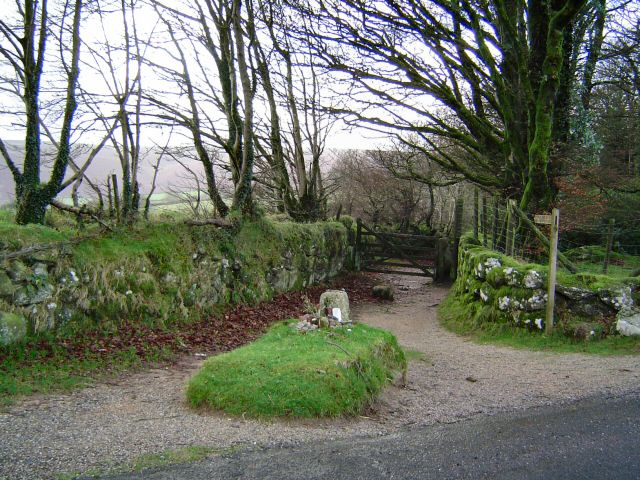By Joe Gardner
On a narrow crossroads in East Dartmoor lies a sombre, stark little tourist attraction known locally as ‘Jay’s Grave.’ It’s a sad but curious sight to behold; a tiny, unmarked piece of granite serving as the headstone atop a grassy, oblong mound.

Image: http://www.geograph.org.uk
For several decades, virtually nothing was known about the person interred beneath, although it had long been the custom to bury victims of suicide at a crossroads rather than in traditional cemeteries. This was upheld for two reasons; foremost, the sin of self-murder forbade the guilty departed to be interred in churchyards. Secondly, and somewhat more superstitiously, it was hoped that burying suicides at a crossroads would confuse their spirits, preventing them from returning to terrorise the living.
While her life was largely unremarkable, it is in death that Kitty Jay has found a degree of fame, or notoriety.
The story of Kitty Jay has undergone several changes since its casual entry into Devonshire folklore in the early Nineteenth Century, but the bare bones have remained largely the same. Supposedly, an orphaned baby girl was given shelter in the poor house situated close by in Newton Abbot. As was the norm at the time, the baby -bereft of a known Christian name- was referred to by a single letter, J being the letter that the poor house had reached in its records. It is also supposed that the baby was given the first name Mary, as ‘Jay’ alone had been a colloquial synonym for a prostitute. How she eventually received the name Kitty is not known, although it is understood to have been when she eventually left the Newton Abbot poor house.
Upon reaching her teens, Kitty Jay remained at the poor house for a brief period wherein she helped look after the younger children and work on the grounds. However, she was eventually sent away to work on Canna farm in Manaton, Dartmoor, where life in the late Eighteenth Century would have been grim and relentless. While working on the farm, Kitty Jay started to receive attention from the farmer’s son and before long had fallen pregnant with his child. Unfortunately, being of a lower class than the farming family and rather new to the place, her word was nothing against his and she was instantly accused of taking advantage of the young man (with her prostitute name helping to add to their convictions). Predictably enough, Kitty Jay was thrown off the farm and branded a whore.
Such a reputation, erroneous as it may have been, would be impossible to shake off in a small community like Manaton and the likelihood of ever finding employment again would have been quickly disregarded by Kitty. Her brief story ends in the most tragic of ways as she was finally found hanging by the neck in one of the barns at Canna farm.

‘The Discovery of Kitty Jay’ by Chris Rawlins Image: http://www.chrisawlins.deviantart.com
Subsequently, Kitty was largely forgotten to history after her burial, until in 1851 a group of men digging up a lane near Manaton happened upon the grave. Uncertain whether what they had found was indeed an interment, they dug further and found the bones of Kitty Jay. The skeleton was then placed in a coffin under the instructions of James Bryant, the then owner of the land in which they were found, and reinterred into the grave.
The gravesite has since found further fame with the help of several early Twentieth Century authors; principally Dartmoor’s Beatrice Chase, who wrote of stumbling upon it in her 1914 novel The Heart of the Moor. Later, the grave served as inspiration for John Galsworthy’s short story The Apple Tree. The story has even cropped up in songs by Wishbone Ash and Seth Lakeman, among others.
However, the most alluring and ethereal aspect of the Kitty Jay gravesite is the intriguing fact that fresh flowers are placed upon the grave every morning, by an anonymous visitor. Superstition surmises that they may be placed there by Dartmoor pixies, or the guilty spirit of the farmer’s son, atoning for his cruelty from the afterlife. Nightly passers-by have reported sightings of a hooded figure crouched beside the grave. It should be said that, having become a well-known Dartmoor landmark, it is not beyond the realms of possibility that the flowers (and occasional other trinkets such as coins and cuddly toys) are the doings of the myriad tourists that visit the area year in, year out. Either way, it is quite humbling that someone of such low status and consequence in life, who departed in so tragic a fashion and was thus denied a proper burial, has since become the focus of such devotion centuries beyond her death.


Kitty did work at Canna farm as she had committed suicide just after she had been kicked of the land.
There is no suggestion that Kitty Jay worked at Canna Farm, which was probably abandoned at the time she lived. She worked on Ford Farm, and hanged herself in an outbuilding belongingness to the set of buildings known as Canna.
Such a sad story.
creapy